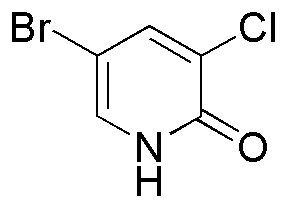5-Bromo-3-chloro-2-pyridinone is widely utilized in research focused on:
- Pharmaceutical Development: This compound serves as a key intermediate in the synthesis of various pharmaceuticals, particularly in the development of antiviral and antibacterial agents.
- Agricultural Chemicals: It is used in formulating agrochemicals, including herbicides and fungicides, helping to protect crops from pests and diseases.
- Analytical Chemistry: The compound is employed as a reagent in analytical methods, aiding in the detection and quantification of other substances in complex mixtures.
- Material Science: It finds applications in creating specialty polymers and coatings, enhancing the durability and performance of materials used in various industries.
- Research in Biochemistry: 5-Bromo-3-chloro-2-pyridinone is utilized in biochemical studies to explore enzyme inhibition and protein interactions, contributing to our understanding of biological processes.
General Information
Properties
Safety and Regulations
Applications
5-Bromo-3-chloro-2-pyridinone is widely utilized in research focused on:
- Pharmaceutical Development: This compound serves as a key intermediate in the synthesis of various pharmaceuticals, particularly in the development of antiviral and antibacterial agents.
- Agricultural Chemicals: It is used in formulating agrochemicals, including herbicides and fungicides, helping to protect crops from pests and diseases.
- Analytical Chemistry: The compound is employed as a reagent in analytical methods, aiding in the detection and quantification of other substances in complex mixtures.
- Material Science: It finds applications in creating specialty polymers and coatings, enhancing the durability and performance of materials used in various industries.
- Research in Biochemistry: 5-Bromo-3-chloro-2-pyridinone is utilized in biochemical studies to explore enzyme inhibition and protein interactions, contributing to our understanding of biological processes.
Documents
Safety Data Sheets (SDS)
The SDS provides comprehensive safety information on handling, storage, and disposal of the product.
Product Specification (PS)
The PS provides a comprehensive breakdown of the product’s properties, including chemical composition, physical state, purity, and storage requirements. It also details acceptable quality ranges and the product's intended applications.
Certificates of Analysis (COA)
Search for Certificates of Analysis (COA) by entering the products Lot Number. Lot and Batch Numbers can be found on a product’s label following the words ‘Lot’ or ‘Batch’.
*Catalog Number
*Lot Number
Certificates Of Origin (COO)
This COO confirms the country where the product was manufactured, and also details the materials and components used in it and whether it is derived from natural, synthetic, or other specific sources. This certificate may be required for customs, trade, and regulatory compliance.
*Catalog Number
*Lot Number
Safety Data Sheets (SDS)
The SDS provides comprehensive safety information on handling, storage, and disposal of the product.
DownloadProduct Specification (PS)
The PS provides a comprehensive breakdown of the product’s properties, including chemical composition, physical state, purity, and storage requirements. It also details acceptable quality ranges and the product's intended applications.
DownloadCertificates of Analysis (COA)
Search for Certificates of Analysis (COA) by entering the products Lot Number. Lot and Batch Numbers can be found on a product’s label following the words ‘Lot’ or ‘Batch’.
*Catalog Number
*Lot Number
Certificates Of Origin (COO)
This COO confirms the country where the product was manufactured, and also details the materials and components used in it and whether it is derived from natural, synthetic, or other specific sources. This certificate may be required for customs, trade, and regulatory compliance.


